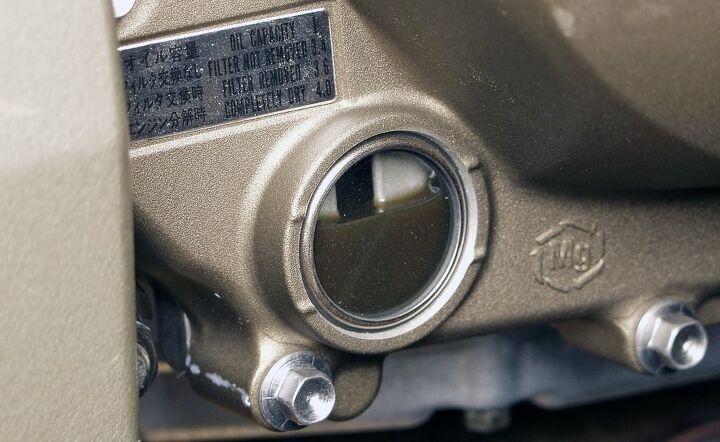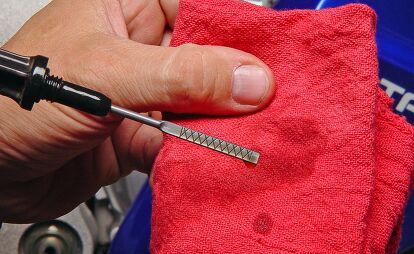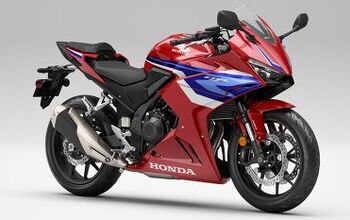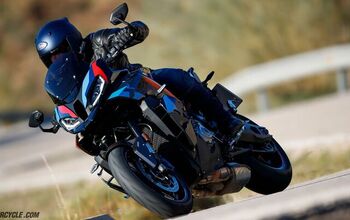How Do You Check A Motorcycle's Oil Level?

Still as important as ever
Modern motorcycles are incredibly reliable, but they still require you to check a few things in order to keep them running at full potential. The engine oil is one of those items you should never neglect. After all, you don’t want to run your high-revving, manufactured-to-aerospace-tolerances, and extremely-expensive-to-replace engine without the proper lubricant, do you? Additionally, an engine’s oil can reveal a good bit of information about the condition of its internals to even a novice mechanic armed with a little information.
To actually check an engine’s oil level, take a look at its owner’s manual. Seriously, it’ll outline the specifics that the manufacturer recommends – and they do vary slightly from bike-to-bike. Still, the steps do follow a rough pattern.
Make sure the engine is warmed to operating temperature. After turning it off, allow the oil to drain down from the top end by waiting a few minutes. Bikes with a sight glass require that you hold the bike level – either from the saddle or beside the bike – look at the window conveniently located on the bottom of the engine to make sure the oil level is between the two marks on the case. (Tip: If your bike has both a centerstand and a sight glass, measure it the above way and then compare it to the level shown while on the centerstand. This way you can use that level as reference so can check the oil level when it’s parked on the centerstand in your garage.)
(UPDATE: One of our readers suggested using a telescopic mirror to help if you don’t have a centerstand or someone else to help hold your bike level. —ed.)
For engines with a dipstick, check your owner’s manual to make certain how the stick is to be inserted for an accurate reading. Usually, you will wipe the stick and insert it into the case until it makes contact with the filler plug’s threads. Be sure the plug is straight and the bike is level or you may get an inaccurate reading.
If you ride your bike regularly, you should check its oil at least weekly. If you ride infrequently, consider checking before every ride. With regular checks, you are more likely to notice symptoms of little problems before they get bigger.
So, how did the oil look when you checked it?
- Nice and amber like the day it was poured out of the bottle is perfect.
- Dark or black indicates the oil needs to be changed.
- Milky white typically means coolant has found its way into the oil, which could indicate a blown head gasket and/or a major engine problem.
- If it smells like gas, it’s time to take it to the shop.
- If the engine has suddenly begun consuming oil, it could mean valve or piston-ring problems, which require investigation to ascertain the cause.
If everything checks out, as it usually will, what are you waiting for? Go riding!
Shop for the motorcycle oil filters here
We are committed to finding, researching, and recommending the best products. We earn commissions from purchases you make using the retail links in our product reviews. Learn more about how this works.

Like most of the best happenings in his life, Evans stumbled into his motojournalism career. While on his way to a planned life in academia, he applied for a job at a motorcycle magazine, thinking he’d get the opportunity to write some freelance articles. Instead, he was offered a full-time job in which he discovered he could actually get paid to ride other people’s motorcycles – and he’s never looked back. Over the 25 years he’s been in the motorcycle industry, Evans has written two books, 101 Sportbike Performance Projects and How to Modify Your Metric Cruiser, and has ridden just about every production motorcycle manufactured. Evans has a deep love of motorcycles and believes they are a force for good in the world.
More by Evans Brasfield































Comments
Join the conversation
Wish I had a site glass. I ride a 2022 Can-Am Ryker 900 Sport. The oil has to be checked at normal operating temperature. Ride the bike to temperature and let it idle. Open the body panel cover and get your wiping rag ready. Stop the engine, remove and wipe the dip stick, reinsert the dip stick and screw it in fully, re-remove the dip stick and check the level. You have ten seconds to perform these functions before the oil drains into the sump. Hope the oil level is good before engine startup or going for the warmup ride. (Most stupidest design I have ever encountered!) Is this the way all Rotax engines are designed??
Dark oil does not necessarily mean it needs changed, it merely means the oil is doing its job of cleaning and suspending contaminants. Time, mileage, driving conditions, mode of operation, all figure into when to change oil, not just the color of the oil.